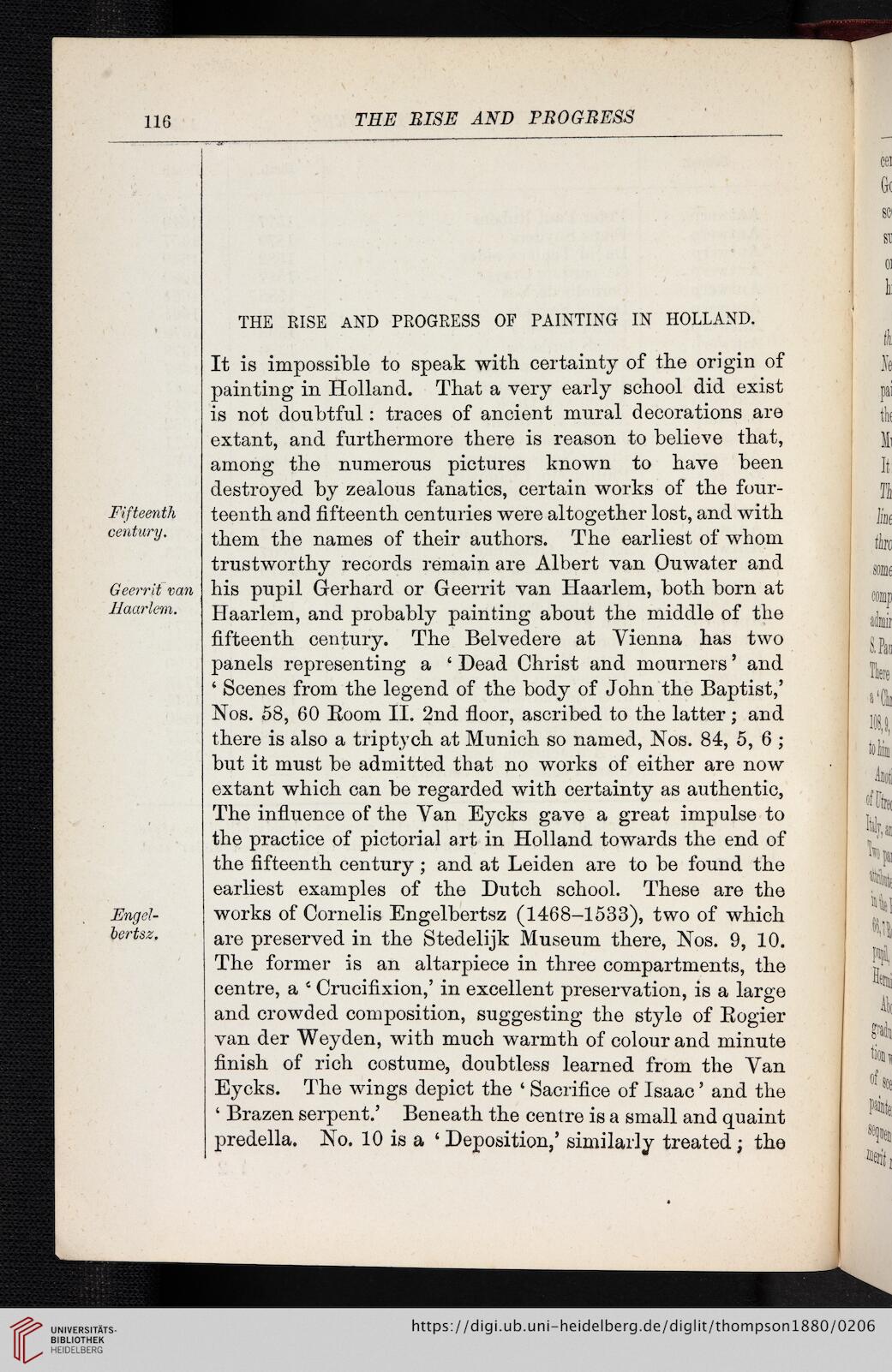116
THE RISE AND PROGRESS
- -=#
Fifteenth
century.
Geerrit van
Haarlem.
Engel-
bertsz.
THE RISE AND PROGRESS OF PAINTING IN HOLLAND.
It is impossible to speak with certainty of the origin of
painting in Holland. That a very early school did exist
is not doubtful : traces of ancient mural decorations are
extant, and furthermore there is reason to believe that,
among the numerous pictures known to have been
destroyed by zealous fanatics, certain works of the four-
teenth and fifteenth centuries were altogether lost, and with
them the names of their authors. The earliest of whom
trustworthy records remain are Albert van Ouwater and
his pupil Gerhard or Geerrit van Haarlem, both born at
Haarlem, and probably painting about the middle of the
fifteenth century. The Belvedere at Vienna has two
panels representing a 'Dead Christ and mourners' and
' Scenes from the legend of the body of John the Baptist,'
Nos. 58, 60 Room II. 2nd floor, ascribed to the latter ; and
there is also a triptych at Munich so named, Nos. 84, 5, 6;
but it must be admitted that no works of either are now
extant which can be regarded with certainty as authentic,
The influence of the Van Eycks gave a great impulse to
the practice of pictorial art in Holland towards the end of
the fifteenth century ; and at Leiden are to be found the
earliest examples of the Dutch school. These are the
works of Cornelis Engelbertsz (1468-1533), two of which
are preserved in the Stedelijk Museum there, Nos. 9, 10.
The former is an altarpiece in three compartments, the
centre, a ' Crucifixion,' in excellent preservation, is a large
and crowded composition, suggesting the style of Rogier
van der Weyden, with much warmth of colour and minute
finish of rich costume, doubtless learned from the Van
Eycks. The wings depict the 'Sacrifice of Isaac' and the
' Brazen serpent.' Beneath the centre is a small and quaint
predella. No. 10 is a 'Deposition,' similarly treated ; the
THE RISE AND PROGRESS
- -=#
Fifteenth
century.
Geerrit van
Haarlem.
Engel-
bertsz.
THE RISE AND PROGRESS OF PAINTING IN HOLLAND.
It is impossible to speak with certainty of the origin of
painting in Holland. That a very early school did exist
is not doubtful : traces of ancient mural decorations are
extant, and furthermore there is reason to believe that,
among the numerous pictures known to have been
destroyed by zealous fanatics, certain works of the four-
teenth and fifteenth centuries were altogether lost, and with
them the names of their authors. The earliest of whom
trustworthy records remain are Albert van Ouwater and
his pupil Gerhard or Geerrit van Haarlem, both born at
Haarlem, and probably painting about the middle of the
fifteenth century. The Belvedere at Vienna has two
panels representing a 'Dead Christ and mourners' and
' Scenes from the legend of the body of John the Baptist,'
Nos. 58, 60 Room II. 2nd floor, ascribed to the latter ; and
there is also a triptych at Munich so named, Nos. 84, 5, 6;
but it must be admitted that no works of either are now
extant which can be regarded with certainty as authentic,
The influence of the Van Eycks gave a great impulse to
the practice of pictorial art in Holland towards the end of
the fifteenth century ; and at Leiden are to be found the
earliest examples of the Dutch school. These are the
works of Cornelis Engelbertsz (1468-1533), two of which
are preserved in the Stedelijk Museum there, Nos. 9, 10.
The former is an altarpiece in three compartments, the
centre, a ' Crucifixion,' in excellent preservation, is a large
and crowded composition, suggesting the style of Rogier
van der Weyden, with much warmth of colour and minute
finish of rich costume, doubtless learned from the Van
Eycks. The wings depict the 'Sacrifice of Isaac' and the
' Brazen serpent.' Beneath the centre is a small and quaint
predella. No. 10 is a 'Deposition,' similarly treated ; the




